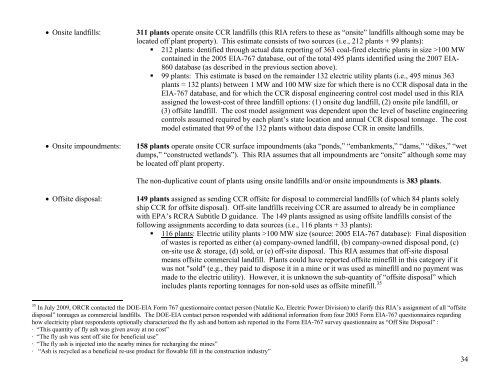Analysis - The Institute for Southern Studies
Analysis - The Institute for Southern Studies
Analysis - The Institute for Southern Studies
Create successful ePaper yourself
Turn your PDF publications into a flip-book with our unique Google optimized e-Paper software.
Onsite landfills:<br />
Onsite impoundments:<br />
311 plants operate onsite CCR landfills (this RIA refers to these as “onsite” landfills although some may be<br />
located off plant property). This estimate consists of two sources (i.e., 212 plants + 99 plants):<br />
• 212 plants: dentified through actual data reporting of 363 coal-fired electric plants in size >100 MW<br />
contained in the 2005 EIA-767 database, out of the total 495 plants identified using the 2007 EIA-<br />
860 database (as described in the previous section above).<br />
• 99 plants: This estimate is based on the remainder 132 electric utility plants (i.e., 495 minus 363<br />
plants = 132 plants) between 1 MW and 100 MW size <strong>for</strong> which there is no CCR disposal data in the<br />
EIA-767 database, and <strong>for</strong> which the CCR disposal engineering control cost model used in this RIA<br />
assigned the lowest-cost of three landfill options: (1) onsite dug landfill, (2) onsite pile landfill, or<br />
(3) offsite landfill. <strong>The</strong> cost model assignment was dependent upon the level of baseline engineering<br />
controls assumed required by each plant’s state location and annual CCR disposal tonnage. <strong>The</strong> cost<br />
model estimated that 99 of the 132 plants without data dispose CCR in onsite landfills.<br />
158 plants operate onsite CCR surface impoundments (aka “ponds,” “embankments,” “dams,” “dikes,” “wet<br />
dumps,” “constructed wetlands”). This RIA assumes that all impoundments are “onsite” although some may<br />
be located off plant property.<br />
<strong>The</strong> non-duplicative count of plants using onsite landfills and/or onsite impoundments is 383 plants.<br />
Offsite disposal:<br />
149 plants assigned as sending CCR offsite <strong>for</strong> disposal to commercial landfills (of which 84 plants solely<br />
ship CCR <strong>for</strong> offsite disposal). Off-site landfills receiving CCR are assumed to already be in compliance<br />
with EPA’s RCRA Subtitle D guidance. <strong>The</strong> 149 plants assigned as using offsite landfills consist of the<br />
following assignments according to data sources (i.e., 116 plants + 33 plants):<br />
• 116 plants: Electric utility plants >100 MW size (source: 2005 EIA-767 database): Final disposition<br />
of wastes is reported as either (a) company-owned landfill, (b) company-owned disposal pond, (c)<br />
on-site use & storage, (d) sold, or (e) off-site disposal. This RIA assumes that off-site disposal<br />
means offsite commercial landfill. Plants could have reported offsite minefill in this category if it<br />
was not "sold" (e.g., they paid to dispose it in a mine or it was used as minefill and no payment was<br />
made to the electric utility). However, it is unknown the sub-quantity of “offsite disposal” which<br />
includes plants reporting tonnages <strong>for</strong> non-sold uses as offsite minefill. 35<br />
35 In July 2009, ORCR contacted the DOE-EIA Form 767 questionnaire contact person (Natalie Ko, Electric Power Division) to clarify this RIA’s assignment of all “offsite<br />
disposal” tonnages as commercial landfills. <strong>The</strong> DOE-EIA contact person responded with additional in<strong>for</strong>mation from four 2005 Form EIA-767 questionnaires regarding<br />
how electricity plant respondents optionally characterized the fly ash and bottom ash reported in the Form EIA-767 survey questionnaire as “Off Site Disposal” :<br />
· “This quantity of fly ash was given away at no cost”<br />
· “<strong>The</strong> fly ash was sent off site <strong>for</strong> beneficial use”<br />
· “<strong>The</strong> fly ash is injected into the nearby mines <strong>for</strong> recharging the mines”<br />
· “Ash is recycled as a beneficial re-use product <strong>for</strong> flowable fill in the construction industry”<br />
34




